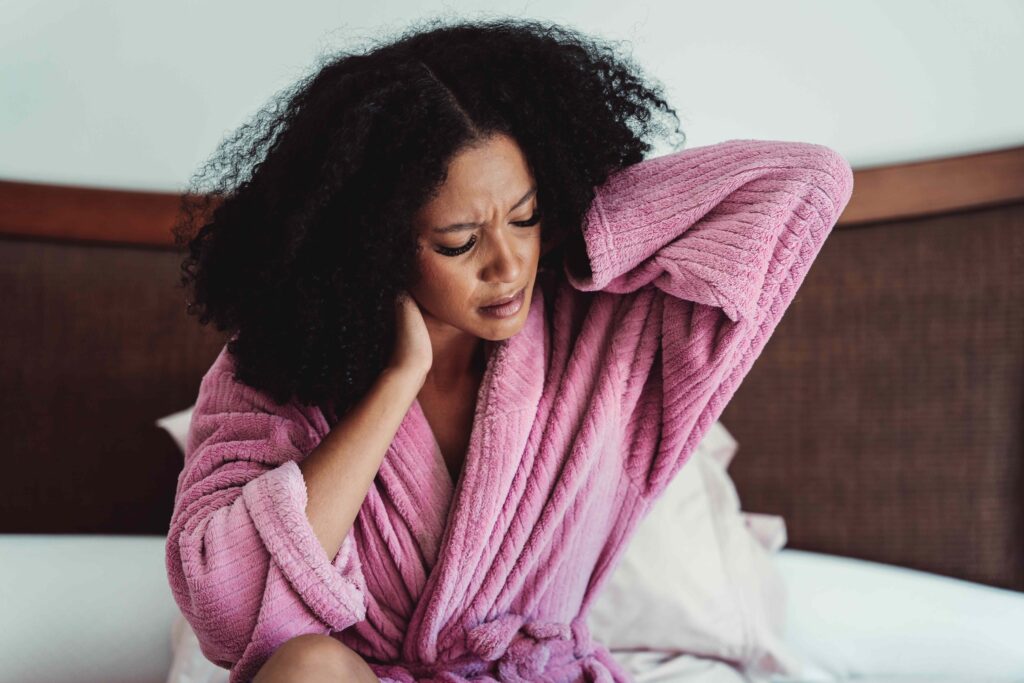Muscle aches and pain, known also as myalgia, are a common symptom of COVID-19. This achiness can happen when the virus triggers body-wide inflammation. The pain typically resolves within about two weeks. Some people who develop long COVID may have muscle pain for weeks or months after.
According to some estimates, about 86% of people diagnosed with COVID experience muscle pain.
With COVID, your body’s immune response to the virus often causes muscle aches. When your immune system detects the virus, it releases special proteins called cytokines. Certain cytokines trigger inflammation, which can lead to muscle and joint aches. Examples of these cytokines include interleukin-6 (IL-6), interleukin-1 (IL-1), and tumor necrosis factor-α (TNF-α).
Some research suggests that the virus may also damage muscle tissue directly by attaching itself to muscle cells, resulting in muscle pain.
Causes in Long COVID
Long COVID is a condition where symptoms last for three months or longer after a COVID infection. Estimates suggest that at least 1 in 10 people with COVID will develop long COVID.
In people who have long COVID, a common cause of muscle pain is ischemic myalgia. Ischemic myalgia is the medical term for muscle pain from a lack of blood flow to the tissues.
Muscle aches that occur with COVID can affect the entire body. In one study, people with COVID most commonly felt muscle pain in their legs, neck, and head.
Joint pain, called arthralgia, is very common with COVID. This pain may affect your wrists, ankles, shoulders, and knees. Many people with COVID experience lower back pain as well.
Muscle aches are often among the first symptoms of COVID. The aches may begin before respiratory symptoms like a cough and shortness of breath. If you have a mild case of COVID, you can usually expect this muscle pain to go away within a week or two. If you become infected after getting a vaccine, your symptoms are likely to be less severe.
If your COVID is more severe, your muscle aches and pain may last longer. In one research review, muscle pain lasted more than four weeks on average for people who had been hospitalized with COVID.
Muscle pain is one of the most common symptoms of long COVID. It can last for weeks, months, or sometimes years after the initial infection clears.
You can usually manage mild COVID symptoms, such as muscle aches, at home.
Your healthcare provider may recommend over-the-counter pain medication to help relieve COVID muscle aches. Pain relievers such as Tylenol (acetaminophen) or nonsteroidal anti-inflammatory drugs (NSAIDs) like Advil (ibuprofen) may help.
Take these steps at home to help reduce muscle pain from COVID:
- Try the RICE method, using rest, ice (for the first three days), compression, and elevation.
- After the icing period, apply heat to the affected muscles.
- Do gentle stretches.
- Gently massage your achy muscles.
- When you feel up to it, try some gentle exercise, such as walking, to strengthen and stretch your muscles.
If muscle aches or other COVID symptoms last for more than a couple of weeks, it’s important to call a healthcare provider.
Management With Long COVID
If your muscle pain persists after the COVID infection passes, consider seeing a physical therapist. They can help you make a plan to relieve pain and heal muscle damage. Physical activity is an important way to lessen muscle pain, especially for people with long COVID.
Muscle aches are extremely common. These aches can result from many conditions other than COVID, for example:
- Muscle injury or strain
- Stress
- Electrolyte imbalance (not having enough minerals like potassium, magnesium, or sodium)
- Use of certain medications, like statins and angiotensin-converting enzyme (ACE) inhibitors
- Other infections, like the flu
- Fibromyalgia
- Inflammatory conditions like lupus, polymyositis, or polymyalgia rheumatica
Taking a COVID test in a clinic or at home can help you determine whether COVID is causing your muscle aches.
Muscle aches are a common symptom of COVID. They are especially common among people who are hospitalized for COVID and those who develop long COVID. Muscle pain may result from inflammation, the virus attacking the muscles, or a lack of oxygen getting to the muscles.
You can treat COVID muscle pain at home with self-care strategies such as pain relievers, stretching, and the RICE method.


